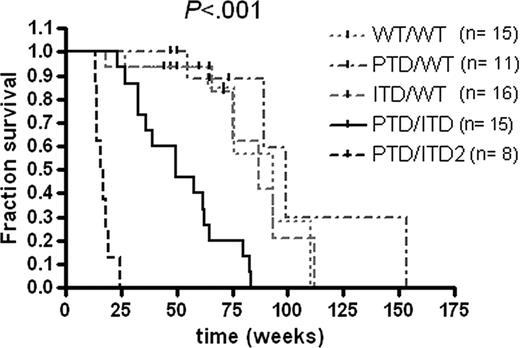Abstract
Abstract 150
The Mll PTD and Flt3 ITD are co-present in a subset of adult patients (pts) with cytogenetically normal (CN) acute myeloid leukemia (AML) and poor clinical outcomes. While the single mutant knock-in (KI) mice (Mll PTD or Flt3 ITD) exhibit enhanced myeloid progenitor self-renewal or reduced apoptosis, respectively, neither model develops acute leukemia. We hypothesized that with mutant expression driven via the endogenous promoters, the two mutations may cooperate in vivo to induce an acute leukemia that mimics the human counterpart.
Single mutant heterozygous KI mice were crossed to produce the PTD/ITD double KI. PTD/ITD mice were bred with the homozygous Flt3 ITD to generate the PTD/ITD2 genotype. An AML diagnosis was based on blood differentials, immunophenotyping, tissue pathology and transplantability. Real time RT-PCR and 5'-methylcytosine LC/MS assays measured gene expression and global DNA methylation levels, respectively.
PTD/ITD and PTD/ITD2 mice developed transplantable, CN-AML/undifferentiated leukemia exhibiting expansion of monocytic/myelomonocytic Gr1±/Mac1+ and/or immature CD3−/CD19−/CD117+/Mac1−/B220lo cell populations, splenomegaly, leukocytosis, anemia and thrombocytopenia. PTD/ITD mice had significantly reduced lifespans compared to mice with single mutant PTD and ITD KIs and wild-type (Wt) controls (medians: 50, 99, 88, 94 weeks, respectively; P<0.001) (Figure 1). Increased ITD gene dosage (PTD/ITD2) was associated with an even shorter lifespan (median: 16 weeks) (Figure 1). This is consistent with the poor prognosis conferred by high FLT3 ITD-to-FLT3 wild-type (WT) gene ratio in diagnostic leukemia blasts from AML pts treated with intensive chemotherapy. As in human MLL PTD AML, the Mll WT allele was downregulated in the murine model. Mll WT expression was >2-fold lower in bone marrow (BM) of leukemic PTD/ITD mice compared to age-matched single mutant KIs or Wt controls. HoxA9 and its cofactor Meis1 were upregulated 15- and 5-fold, respectively, in PTD/ITD mice with leukemia versus Wt BM. Yet, compared to Wt BM, single PTD KI exhibited increased HoxA9 (∼6-fold) but not Meis1, implicating an expression threshold for HoxA9 and a crucial role for Meis1 for the development of acute leukemia in the double KI. Consistent with Flt3 being a downstream transcriptional target of Meis1, total Flt3 mRNA (WT and ITD) levels increased 3-fold in the leukemic PTD/ITD mice relative to either single mutant KIs or Wt controls. Furthermore, one consequence of constitutive Flt3 ITD kinase activity is the upregulation of the anti-apoptotic kinase, Pim1, in human AML. Compared to Wt BM, a 2-fold increase in Pim-1 expression was observed in single ITD KI and a 6-fold increase was observed in leukemic PTD/ITD BM, while expression was unchanged in the single PTD KI BM. Finally, MLL PTD presence in human AML associates with increased global DNA methylation and silencing of tumor suppressor genes. We observed 3-fold higher transcript levels of a de novo methyltransferase, DNA methyltransferase 3b (DNMT3b), increased global DNA methylation and ≥2-fold decrease in the expression of tumor suppressors Id4, Shp1 and Cdkn1b in BM of leukemia PTD/ITD mice compared to age-matched single mutant KIs and Wt controls.
The Flt3 ITD and Mll PTD, expressed via their endogenous promoters, cooperate in vivo to give rise to AML and acute undifferentiated leukemia. Elevations of Meis1 and DNMT3b solely in PTD/ITD animals appear to be critical points of dysregulation leading to development of acute leukemia. This novel murine model phenotypically, molecularly, and epigenetically mimics the human AML counterpart, thus making it highly relevant for examining critical pathways in acute myeloid leukemogenesis, investigating leukemia stem/initiating cell biology and microenvironment contributions, and testing novel targeting therapeutics.
Kaplan-Meier survival plots for wild-type controls (WT/WT), single knock-in mice with PTD/WT or ITD/WT genotypes and PTD/ITD mice with heterozygous PTD and ITD alleles and PTD/ITD2 mice with heterozygous PTD and homozygous ITD alleles.
Kaplan-Meier survival plots for wild-type controls (WT/WT), single knock-in mice with PTD/WT or ITD/WT genotypes and PTD/ITD mice with heterozygous PTD and ITD alleles and PTD/ITD2 mice with heterozygous PTD and homozygous ITD alleles.
No relevant conflicts of interest to declare.
Author notes
Asterisk with author names denotes non-ASH members.


